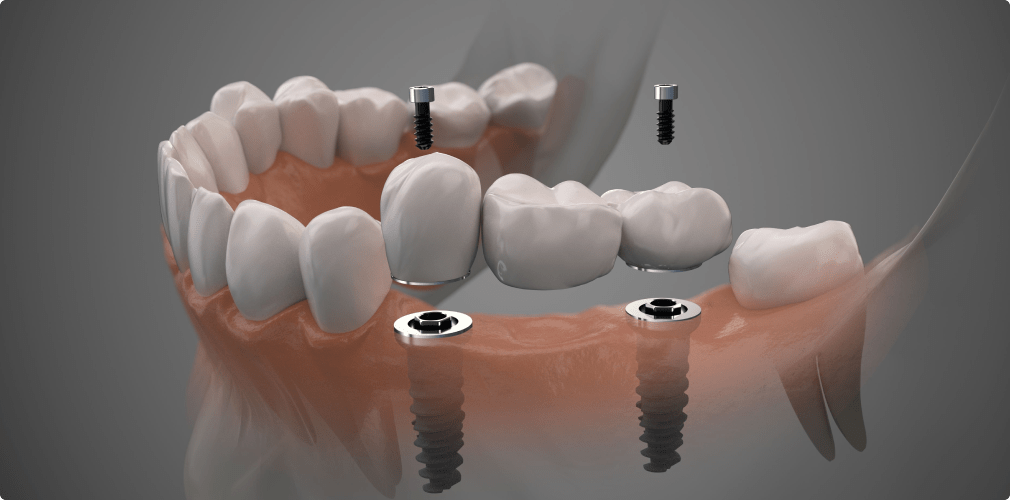Comfortable and safe, implant placement is carried out in several stages as part of a follow-up program set up with your dental surgeon. Highly resistant and biologically compatible, the material used is supplied by a high-tech laboratory.
Implants have become a common language in dental prosthetic rehabilitation. They are the solution of choice for their longevity and comfort. Thanks to them, it’s possible to replace one or more missing teeth (missing or extracted teeth) as if they were new teeth.
What is an implant?
They are often confused with dental crowns. To understand what an implant is, you first need to understand the anatomy of a tooth: a tooth has a radicular part (the root or roots, in the bone) and a coronal part (the natural crown, the part seen in the mouth).
When a tooth is simply damaged, we can replace the top part (the crown) with a prosthetic element: for example, an artificial crown in metal or ceramic that will rest on the natural root(s) of your tooth. Crowns are therefore attached to part of your remaining teeth. But that’s not the case with implants!
If your tooth is too badly damaged and needs to be avulsed (extracted): there will be nothing left of either the root or the crown. Unfortunately, it’s impossible to attach an artificial crown to bone or gum alone… which is precisely where the implant comes in.
The implant is a cylindrical piece of titanium that is inserted into the jawbone to replace the root of a missing or lost tooth that needs to be extracted.

How is it set up?
Under anaesthetic, the gum is pulled aside so that the implant can be placed in the bone. Once the implant is in place, a healing screw covers it to protect the healing process. It will then either be completely covered by the gum (buried healing) or the screw will remain visible. Depending on practice, the sutures used to reposition the gingiva may be absorbable, or they may be removed a few days after surgery.
Except in the case of “immediate loading” (described below), an implant is not placed at the same time as its prosthesis. The implant is initially placed on its own, after which it is left to heal for around 3 months: this is the osseointegration phase. It’s important that the bone around the implant is firmly healed to ensure that the treatment lasts over time.
Requirements for dental implants
In most cases, an implant is placed on healed, healthy bone. It may take several months after a tooth extraction before you can have your implant fitted (except for immediate implants, described below).
There are few medical contraindications to implants; your practitioner will inform you of them on the basis of your health questionnaire.
However, there are anatomical limits. For example, the most common barrier is a lack of bone volume: the support must be able to properly accommodate and support the implants. If the bone does not have the correct initial configuration, you may be offered tissue modifications (bone graft, sinus lift…).
These gaps can, for example, be anticipated during tooth extraction, with bone filling performed in the same session as the avulsion.
Can everything be replaced with dental implants?
Implant-supported crowns, implant-supported bridges, implant-supported removable prostheses, implant-supported screw-retained total prostheses… There are so many possibilities with implant techniques! Talk to your practitioner, there are solutions to many situations, and certainly to yours.
Immediate implantation: teeth fixed in one day
What if it were possible to put a smile back on your face in just one day? Fixed teeth in one day, with less trauma, less post-operative discomfort and fewer trips to the dentist.
Thanks to this technique, you can avoid the disadvantages of removable prostheses by placing fixed teeth on implants that are fitted in just a few hours. A fast, practical solution that can also be a long-term solution.
The process is relatively simple: a few days before or the same day, we take a scan and digital impressions so that together we can plan your new smile, designing your teeth in an aesthetic and natural way. The aim is to achieve the best possible result that meets your expectations. The cost of this type of procedure is lower than that of bone grafting techniques, which are more expensive and time-consuming.
All-on-4®
Have you ever imagined a procedure where, with just 4 dental implants, you can have a fixed rehabilitation with teeth fitted in just a few hours? It’s a concept we’re used to proposing to our patients who have little bone and intend to have teeth placed in their mouths on the same day as the implants. Fast treatment that will increase your quality of life:
- No need for bone grafts
- Shorter processing times
- Cost reduction
- Stability even with low bone volume
Treatment with All-on-4® is a scientifically proven concept, with a 20-year follow-up and success rates of between 96% and 98% at 10 years in the mandible and 5 years in the maxilla, with stabilization of bone level and gingival tissue. A concept that will improve your quality of life!
All-on-6®
This is a procedure very similar to All-on-4 ® , but in which the patient has a greater available bone volume, enabling the placement of 2 additional implants, providing reinforcement and better distribution of masticatory forces.
How do I care for my dental implants?
Just like your teeth, hygiene must be scrupulous: cleaning is recommended two or three times a day with a toothbrush and interdental brushes. Dental jets with special tips for implants are also available. In addition, you should visit your dentist regularly for check-ups.
It should be noted that smoking, diabetic imbalance and other factors can contribute to implant rejection or loss.
Also worth seeing: Crowns at Dr Maire’s dental office in Lisbon